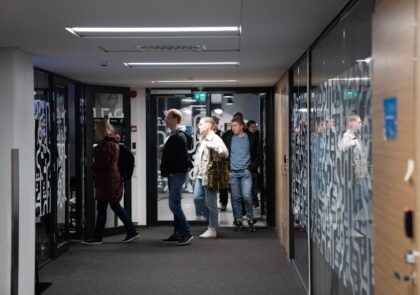
Books and publications on digital inclusion outline multiple reasons for online and offline product inaccessibility. However, the fundamental barrier is in attitudes and the cultural perception of disability. The objective of the article is to introduce methods of changing the perception, which can ultimately lead to more accessible software development.
Authors: Mariia Nedelkina & Tarja Keski-Mattinen
Diversity and inclusion are widely used words. Organisations, project initiatives, and events claimed diverse thrive on vibrant multicultural collaboration and thus, easily reach efficiency goals. Usually, similar endeavours welcome participants regardless of race, gender, or sexual orientation. However, contributors with disabilities are rarely emphasised. That is one of many pieces of evidence of the historical exclusion of the disabled from social experiences. Due to the decades of negligence, the birth and development of technology have also overlooked the vast user segment of people with disabilities. (Lazar et al. 2015, 220.)
Despite the legal efforts of governments to change the situation in the IT sector, very few websites are accessible to people with disabilities (AccessiBe 2019). Nedelkina (2022, 15) highlights several barriers to accessible software development identified by the World Health Organisation and World Bank (2011). They are
- Inappropriate standards and policies
- Lack of funding
- Poor training of staff
- Omission of the disabled in decision-making
- Lack of attention to relevant data
- Stereotypes and prejudice.
However, one of them is causal to the rest, and that is the last attitudinal barrier. Lazar and his colleagues (2015, 221) are sure that changing the attitude or rather the cultural perception of disabilities is the only way to inclusive technology.
The current cultural meaning of disability
In discussions about the disabled, an able-bodied person may face the distinct borderline between “them” and him-/herself. It is observable in many perception models of disability: medical, economic, and charity/tragedy models (The Disabled World 2010). The most widespread narrative is disability as a tragedy caused by limiting circumstances that, according to the abled, should be eliminated. The narrative is reinforced by designated charities for disabled individuals that depend on the sponsorship of able-bodied people (Janz & Stack 2017). Not only this charity concept pictures the current social dynamics and alignment of roles but also influences the self-perception of people with disabilities. Being the most disastrous consequences, the feeling of inferiority and conviction in own incapacity, which are implanted by the society, may have an irreversible effect. (Lazar et al. 2015, 223.)

Image 1. Stepstool as an ordinary device addressing the lack of height (Pxhere 2017)
The counter-model of disability interpretation
The counter-narrative considers disability as a trait such as hair colour or height. Similarly, to a short person using a stepstool to reach a high shelf (Image 1), a visually impaired user resorts to a screen reader to surf the web. As the height in the first case, the impairment is a characteristic, not a segregating attribute, and continues to be so if there are alternative methods of completion for any task. At worst, with no alternative options, the trait becomes an excluding barrier to any undertaking. (Lazar et al. 2015, 229.)
How to change the current cultural perception of disability
To abandon the tragedy narrative, people without disabilities have to see how independent yet successful the disabled are in their own daily and social activities. Visibility is likely to change the existing norms. For that, an enabling all-round environment is needed. (Lazar et al. 2015, 231.)
Nedelkina (2022, 55) gives advice on how technology companies could make digital environments more accessible, while Lazar and his colleagues (2015, 231) suggest more general steps applicable to both private and public sectors. Varying in size and nature, businesses play a major role in the urban ecosystem and lives of individuals: from construction companies to grocery stores and mobile taxi applications. Therefore, Lazar and his co-authors appeal to organisations to:
- Establish and follow unambiguous corporate policies, which are likely to foster corporate responsibility and open the dialogue with clients with disabilities.
- Generate market demand by making purchasing accessibility-driven. The buyer has to request accessibility-compliant products, and the seller should be able to demonstrate their accessibility. Ideally, the action programme results in vibrant competition among the most inclusive offerings, whose accessibility comes by default. Then the wall in front of the disabled will fall, and they will step into a new, culturally transformed world.
On their own, the actions may require prior efforts from the management to educate staff on accessibility. For IT companies, the concrete steps that highlight the importance of accessibility-friendly prioritisation, peer-learning, and testing are outlined by Nedelkina (2022, 55).
In summation
The existing perception of disability not only compromises the position of the disabled on the social level but also instils them with an idea of personal incapacity. The least harmful disability narrative that the abled individuals should follow is disability as a characteristic. People openly treating their disabilities as traits will make the wider public do the same. However, corporations play an important role in building a supportive and accessible environment, where the disabled can safely demonstrate their independence.
References
AccessiBe. 2019. We Analysed 10,000,000 Pages and Here’s Where Most Fail with ADA and WCAG 2.1 Compliance. Cited 22 May 2022. Available at https://accessibe.com/blog/knowledgebase/we-analyzed-10000000-pages-and-heres-where-most-fail-with-ada-and-wcag-21-compliance
Disabled World. 2010. Models of Disability: Types and Definitions. Cited 22 May 2022. Available at https://www.disabled-world.com/definitions/disability-models.php
Janz, H. L. & Stack, M. 2017. Think disability is a tragedy? We pity you. The Conversation. Cited 21 May 2022. Available at https://theconversation.com/think-disability-is-a-tragedy-we-pity-you-82047
Lazar, J., Goldstein, D. & Taylor, A. 2015. Ensuring digital accessibility through process and policy. Amsterdam, Netherlands: Morgan Kaufmann. Cited 22 May 2022. Available at https://lut.primo.exlibrisgroup.com/permalink/358FIN_LUT/b5ag28/alma991938348706254
Nedelkina, M. 2022. Characteristics of an accessible web product and how to implement them. Bachelor’s thesis. LAB University of Applied Sciences, Faculty of Business and Hospitality Management. Lahti.
PxHere. 2017. Table-growth-wood-chair-stool-sitting. Cited 7 Jun 2022. Available at https://pxhere.com/fi/photo/853950
World Health Organisation & World Bank. 2011. World report on disability 2011. World Health Organisation. Cited 22 May 2022. Available at https://apps.who.int/iris/handle/10665/44575
Authors
Mariia Nedelkina is a graduating Business Information Technology student at LAB University of Applied Sciences.
Tarja Keski-Mattinen is a Senior Lecturer of Business Information Technology at LAB University of Applied Sciences and an expert at the LAB CX Group.
Illustration: https://pxhere.com/fi/photo/625549 (CC0)
Published 7.6.2022
Reference to this article
Nedelkina, N. & Keski-Mattinen, T. 2022. How to eliminate the cultural attitude to disability as a tragedy? LAB Pro. Cited and date of citation. Available at https://www.labopen.fi/lab-pro/how-to-eliminate-the-cultural-attitude-to-disability-as-a-tragedy/






